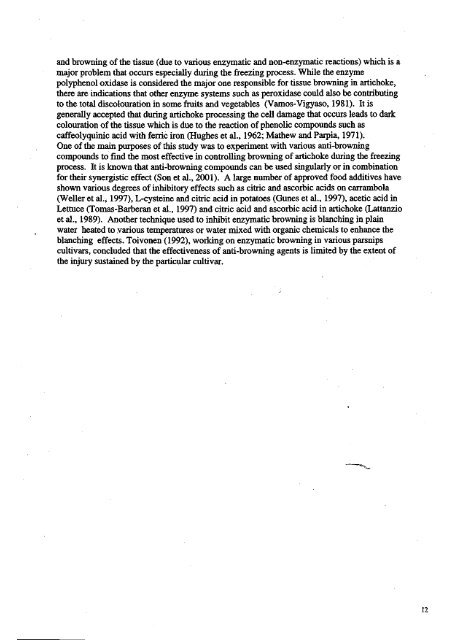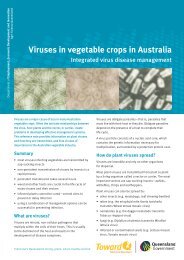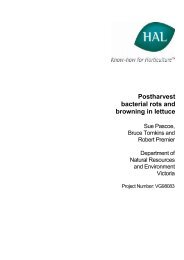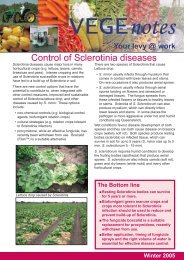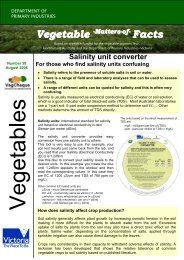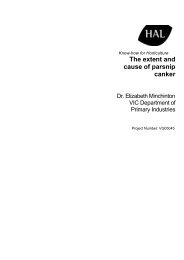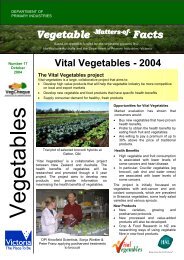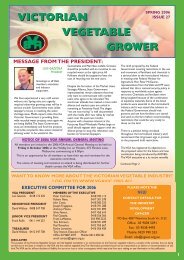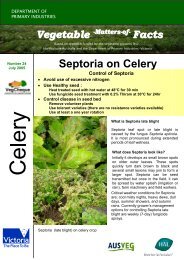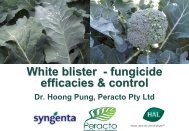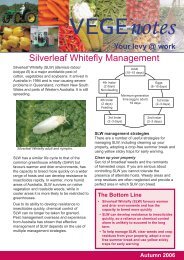sources of animal feed. Work on animal nutrition in Italy has shown that adding artichokebracts <strong>to</strong> lambs' feed led <strong>to</strong> the lowering of fatty acid components <strong>and</strong> cholesterol in the meatproduced (Marsico et al., 2000).3.6 Food trends <strong>and</strong> <strong>consumption</strong>Changes in consumers' lifestyles including buying <strong>and</strong> eating habits are occurring at a fastrate in many developed countries. Australia, according <strong>to</strong> the vegetable industry strategicplan, has undergone significant demographic changes that have brought a diversity of foodwhich modified consumers behaviour <strong>and</strong> lifestyle trends (Anon., 1999b). These changescould also be partially attributed <strong>to</strong> the global economic transformation <strong>and</strong> the informationrevolution that is taking place at a fast rate. With the health message becoming widely spread<strong>and</strong> more noticeable, consumers are turning more <strong>to</strong> fruit <strong>and</strong> vegetables <strong>and</strong> away from meat<strong>and</strong> dairy products. In the USA, red meat <strong>consumption</strong> declined 17% over a period of 30years from 79% in 1970 <strong>to</strong> 62% in 2000 (Anon., 2001b).Between 1955 <strong>and</strong> 1995, the Australian per capita <strong>consumption</strong> of <strong>to</strong>tal fresh vegetable hasincreased by 39% (from 117 <strong>to</strong> 163 Kg) (Anon., 1998b). 1997/98 Horticultural StatisticsH<strong>and</strong>book. Australian Horticultural Corporation, Sydney]. Reports from the USA put theyearly per capita <strong>consumption</strong> of artichoke at 272g (Anon.,1999c), about ten times that ofAustralia (28g) (Hoffmann, 2000), whereas in a country like Italy per capita <strong>consumption</strong> ofartichoke is 7kg (Bianco,2000).Analysing food trends around the world, Daly et. al. (1997) found that leading vegetableproducing countries are increasingly relying on value adding of products. The study alsofound changes in consumer behaviour which is having an impact on the vegetable sec<strong>to</strong>r suchas an increasing trend <strong>to</strong>wards convenience foods (eg. supermarkets offering "meals <strong>to</strong> go""heat <strong>and</strong> eat" etc.). While at the moment Australian consumers lack awareness of suchmeals, there could be a big opportunity for hotels <strong>and</strong> restaurants (George, 2000). Marketresearch claims that Australian shoppers will be able <strong>to</strong> order over the fax or phoneconvenience meals from a new breed of supermarkets (Anon., 1998c). Recent reportsindicate that Australians already spend more than $920 million a year shopping on-line forconvenience, a figure that's set <strong>to</strong> skyrocket in the future (Sloane, 2000). A similar study byHughson (1997) shows scope for the introduction of new frozen value-added vegetablesproducts. Between 1984 <strong>and</strong> 1990 sales of frozen meals in Australia grew from $10 million <strong>to</strong>$80 million (Anon., 1995). Australians consume about 500 grams of frozen meals per capitaper annum well behind the UK (1000 grams) <strong>and</strong> the USA (2000 grams). The frozen mealsmarket in Australia has a retail value of $100 million (Quin<strong>to</strong>n Wilkinson, personalcommunication).Changes in food <strong>consumption</strong> patterns duet<strong>to</strong> changes in lifestyle are also taking place inoverseas countries. For example in Japan (aTmajor market for Australian food <strong>export</strong>s) wheredem<strong>and</strong> for fast <strong>and</strong> convenience foods is increasing. The quantity of frozen vegetablesimported over a,period of eight years from 1988 <strong>and</strong> 1996 increased by 90% (from 333,709<strong>to</strong>nnes <strong>to</strong> 633,008 <strong>to</strong>nnes) (Nguyen, 1998). The import of processed artichokes <strong>to</strong> the USAincreased by 89% from 19,157 <strong>to</strong>nnes <strong>to</strong> 36,284 <strong>to</strong>nnes (Hofmann,1999-personalcommunication).3.7 Anti-browning compoundsThe fruit <strong>and</strong> vegetable processing industry is undergoing constant development in response<strong>to</strong> the ever increasing dem<strong>and</strong> for high quality convenience products. Processing involvesvarious operations such as cutting, ttimming <strong>and</strong> peeling, all of which induce discolouration11
<strong>and</strong> browning of the tissue (due <strong>to</strong> various enzymatic <strong>and</strong> non-enzymatic reactions) which is amajor problem that occurs especially during the freezing process. While the enzymepolyphenol oxidase is considered the major one responsible for tissue browning in artichoke,there are indications that other enzyme systems such as peroxidase could also be contributing<strong>to</strong> the <strong>to</strong>tal discolouration in some fruits <strong>and</strong> vegetables (Vamos-Vigyaso, 1981). It isgenerally accepted that during artichoke processing the cell damage that occurs leads <strong>to</strong> darkcolouration of the tissue which is due <strong>to</strong> the reaction of phenolic compounds such ascaffeolyquinic acid with ferric iron (Hughes et al., 1962; Mathew <strong>and</strong> Parpia, 1971).One of the main purposes of this study was <strong>to</strong> experiment with various anti-browningcompounds <strong>to</strong> find the most effective in controlling browning of artichoke during the freezingprocess. It is known that anti-browning compounds can be used singularly or in combinationfor their synergistic effect (Son et al., 2001). A large number of approved food additives haveshown various degrees of inhibi<strong>to</strong>ry effects such as citric <strong>and</strong> ascorbic acids on carrambola(Weller et al., 1997), L-cysteine <strong>and</strong> citric acid in pota<strong>to</strong>es (Gunes et al., 1997), acetic acid inLettuce (Tomas-Barberan et al., 1997) <strong>and</strong> citric acid <strong>and</strong> ascorbic acid in artichoke (Lattanzioet al., 1989). Another technique used <strong>to</strong> inhibit enzymatic browning is blanching in plainwater heated <strong>to</strong> various temperatures or water mixed with organic chemicals <strong>to</strong> enhance theblanching effects. Toivonen (1992), working on enzymatic browning in various parsnipscultivars, concluded that the effectiveness of anti-browning agents is limited by the extent ofthe injury sustained by the particular cultivar.


